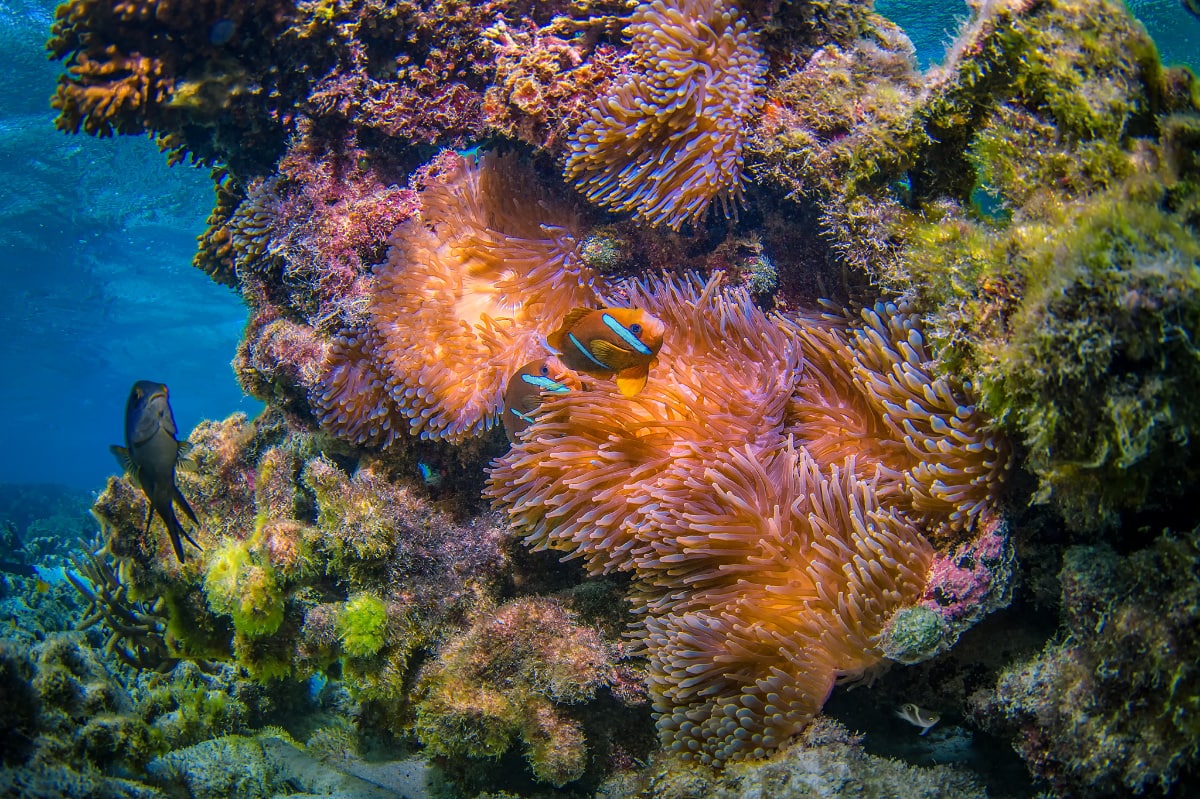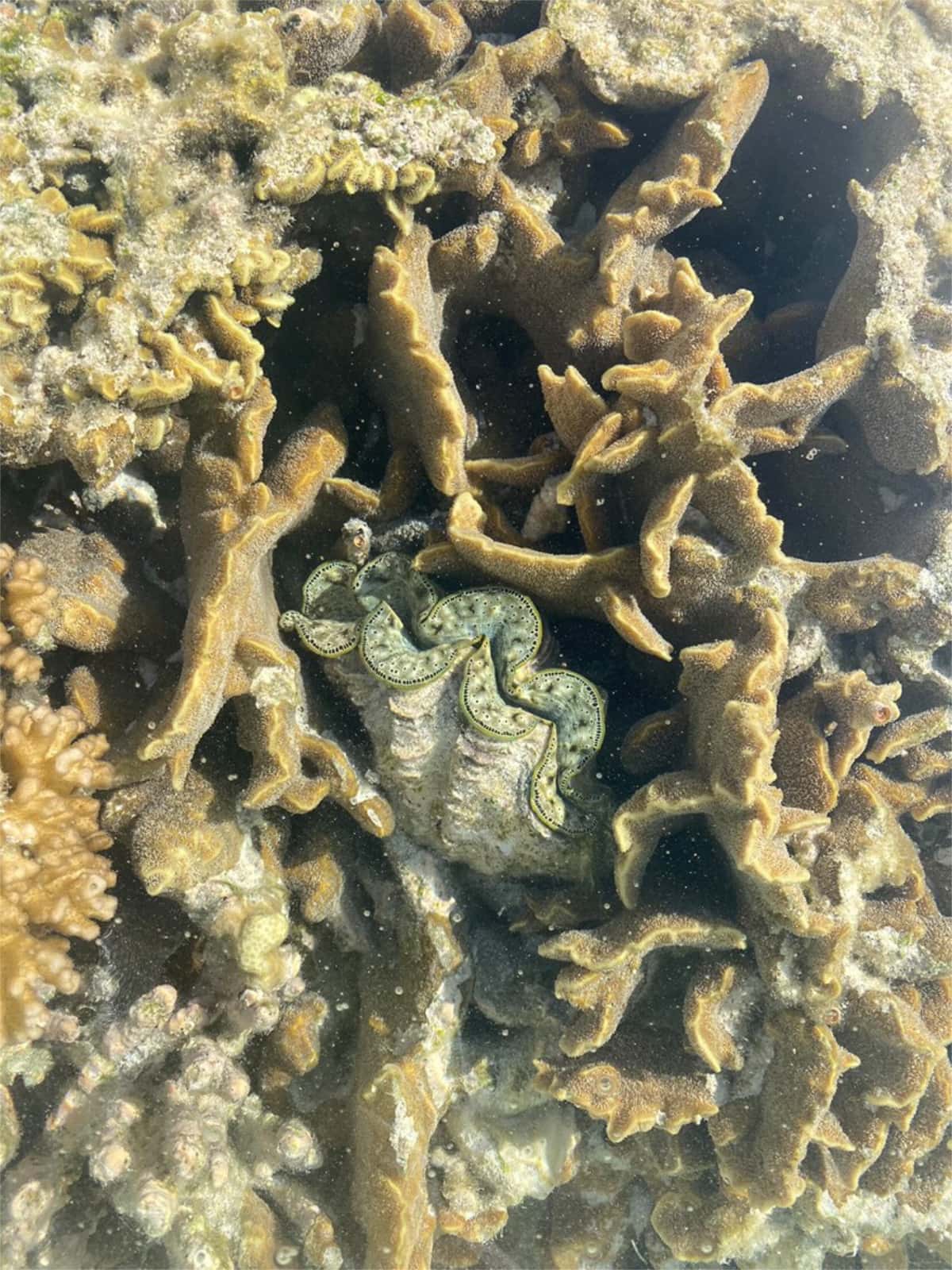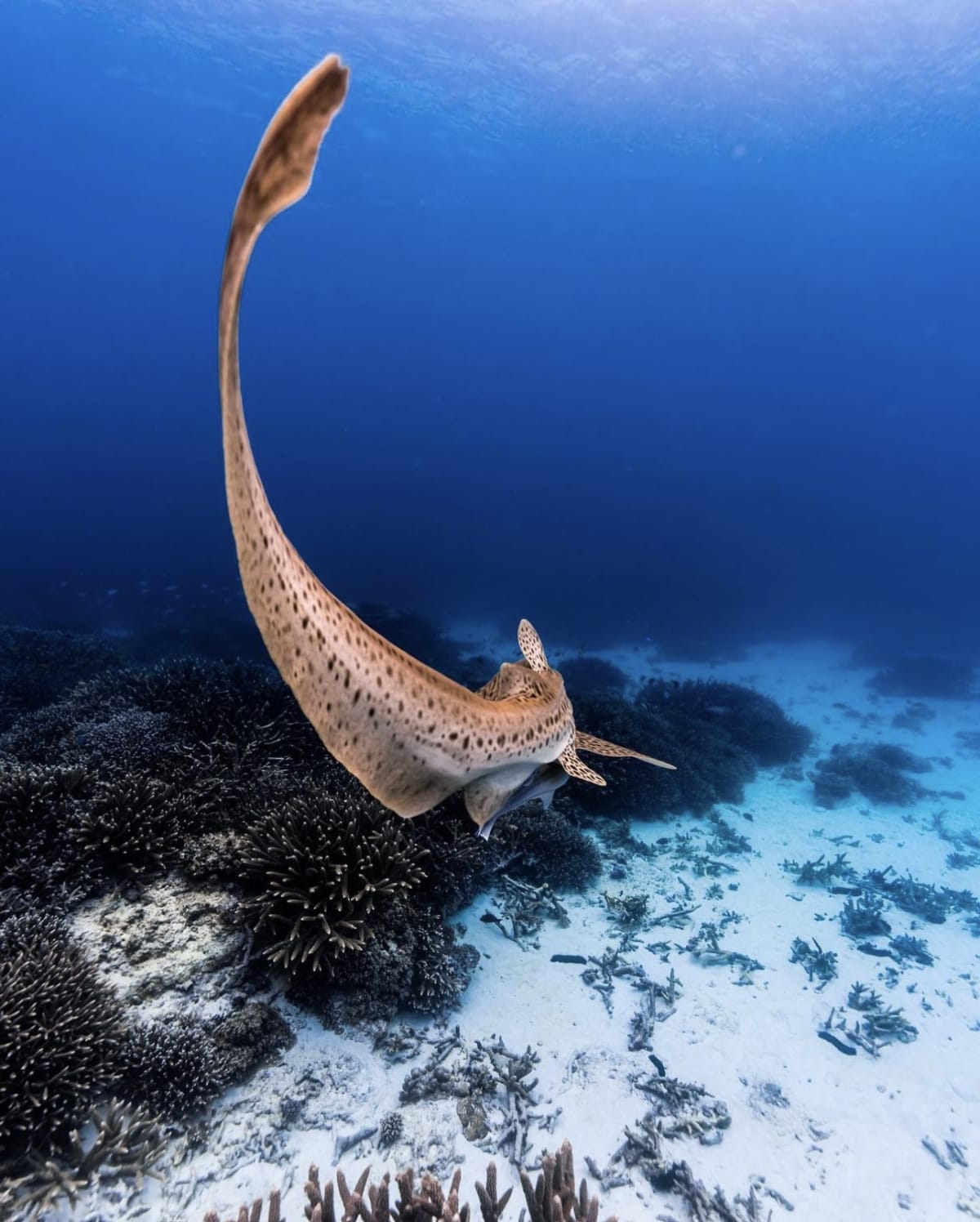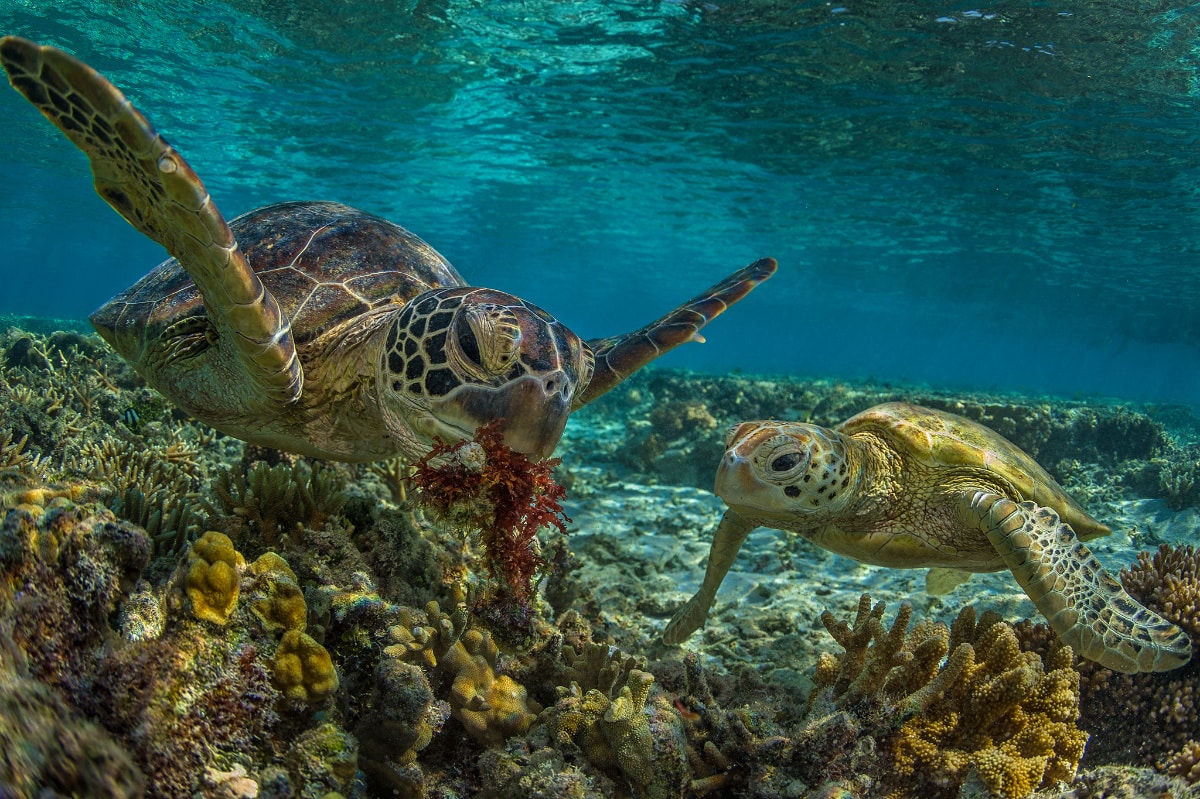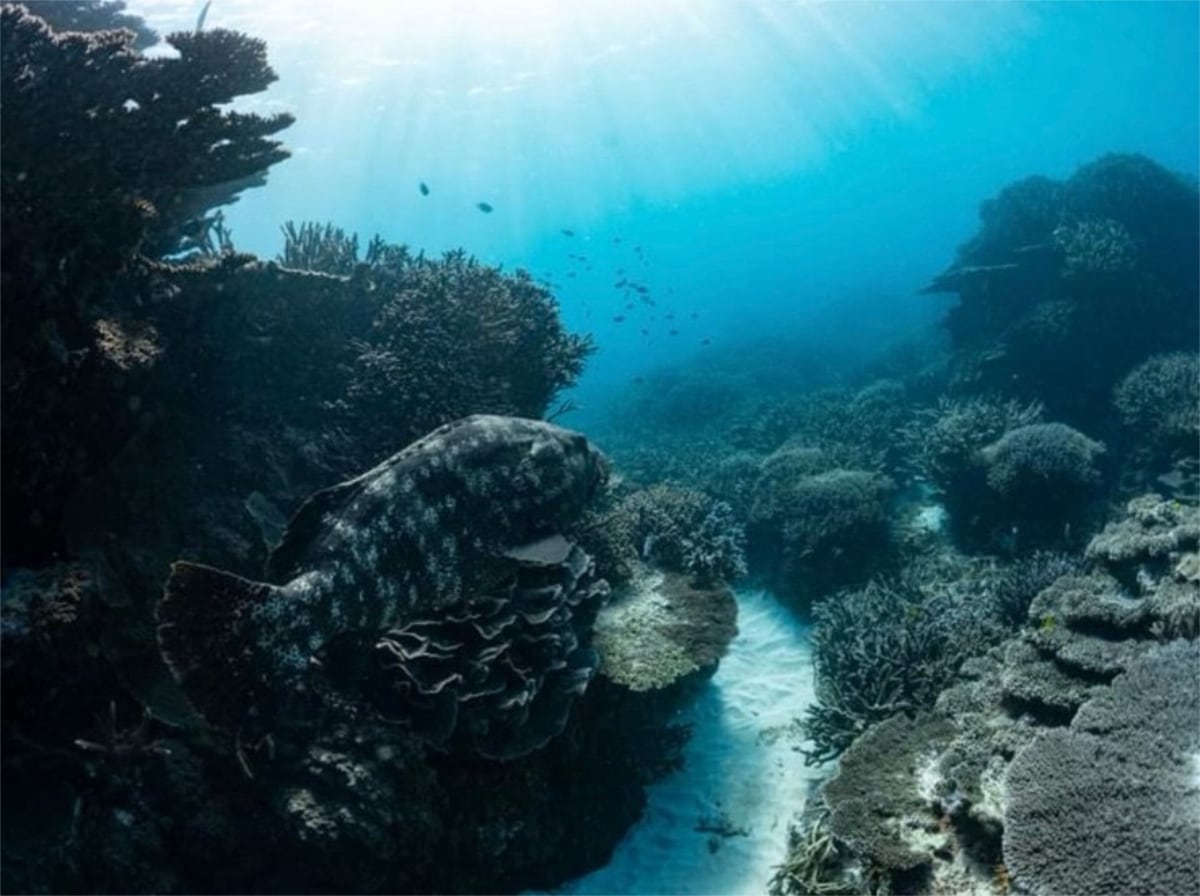What is the Great Eight?
While Africa boasts the Big Five, the Great Barrier Reef has the Great 8. A selection of some of the Reef’s most iconic and favourite inhabitants. The Great 8 reflect the diversity and beauty of the World Heritage Listed Marine Park and are high on visitors’ must-see lists!
From reptiles to mammals, small to large, these key species of the Reef can be found in various locations throughout the Marine Park, but here is where you can spot them on Lady Elliot Island!
1. Anemonefish
An abundance of Anemonefish can be found in the waters surrounding Lady Elliot Island! You can begin your search in our lagoon, where, even on the reef walking track you can spot several small purple anemones hidden beneath holes in the coral structure. As you follow channel one out further, keep an eye on your right-hand side where several anemones are located on the edges of branching coral colonies that have been naturally moulded into a circular shape.
Continue out towards the green cleaning station flag at the back of the lagoon and you will come across some larger anemones on the side of corals. Over on the western side of the island, there is a large pink anemone on the second reef slope, home to a few pink anemonefish and at the start of this snorkelling line is a large bommie jam-packed with Clarkes anemonefish!
2. Giant clams
It’s time to meet one of the oldest animals on the reef! The Giant clam can live to over 100 years old and weigh over 200kg! Sporting a range of stunning colours and patterns, these huge Molluscs get their colours from the photosynthetic algae also found in coral, Zooxanthellae.
To find a Giant clam around Lady Elliot Island, you can first start with a reef walk or snorkel in the lagoon. Begin at the boulder coral at the lagoon entrance and take around 15 steps to put you in front of a green clam. Our guided reef walking tours will point out several of these beautiful animals, or you can explore the area for yourself, and you may notice some of the large blue and green clams near the turtle cleaning station at the back of the lagoon. Keep an eye out during snorkels at second reef too as they are dotted amongst the coral.
3. Māori wrasse
The Māori Wrasse is aptly named from its intricate facial patterns and is the largest member of the wrasse family. This species has been protected in the Marine Park since 2003 and is one of the only natural predators of the Crown of Thorns starfish. A handful of them are sighted around Lady Elliot Island frequently and they are a fairly site attached species.
Take a look at the pink anemone on second reef as a large male Māori wrasse often waits here for a clean from the blue streak cleaner wrasse.
4. Sharks
133 species of shark and ray call the Great Barrier Reef home and range in size from small to huge, like the Whale Shark! Sharks play a key role in the ecosystem where they control numbers of sick or injured animals, keeping populations healthy.
We see around 30 different species of shark frequently around Lady Elliot Island. In the lagoon you are likely to see Epaulette sharks, grey carpet sharks, blacktip and white tip reef sharks while on the western side of the island you can see Tawny nurse sharks, blacktip and whitetip reef sharks, grey reef sharks, hammerhead sharks, tiger sharks and more!
5. Turtles
Sea turtles are high on the list of hopeful sightings during a trip to the Great Barrier Reef! Here on Lady Elliot Island, they are everywhere! Green, Hawksbill and Loggerhead turtles call the island home with Green and Loggerhead turtles nesting here from November to April each year.
Take a snorkel in the lagoon to meet the resident juvenile Green and Hawksbill turtles or jump in on the Western side to meet any of the three species. Join a snorkel safari or glass bottom boat tour for a turtle experience with one of our guides who know just where to look for these charismatic reptiles!
6. Whales
May and June mark the start of whale migration along the East coast of Australia. These giant Cetaceans make their way up both the East and West coastlines of Australia in search of warmer waters to mate and calve. Hervey Bay is a perfect rest stop for these animals thanks to its protection from K’gari, creating a sheltered bay. Lady Elliot Island has also been a popular stop off for many individuals over the years with sightings of small and large pods, heat runs and very new calves sighted by guests and staff.
To spot Humpback Whales, keep your eyes peeled during the flights to and from the island. Choose an outdoor seat at the restaurant facing the lagoon to increase your chances and spend as much time out on the water as you can! Did we mention you can even hear them underwater? Grab a mask and fins and make your way out for a snorkel, you can occasionally hear the whales right at the surface but if you submerge a little deeper you will hear the sounds amplified! Overall, Humpback Whales can be sighted anywhere around the island during the months of June to October.
7. Cods and groupers
The largest bony fish on the reef who capture their prey with a strong inhale! The best known of this group is the potato cod which earns its name from the potato shaped patterns on its body. The Potato cods cousin, the Queensland Grouper has even been recorded weighing over 350kg and measuring over 2m! To see a cod or grouper around Lady Elliot Island, there are several places we recommend checking.
Around the coral gardens area are numerous coral overhangs, underneath which sit Malabar groupers. We see these groupers in the tidal lagoon early in the morning. You can also occasionally spot some huge footballers cods at the second reef mooring block on the sand.
8. Manta rays
Lady Elliot Island is well known as “The Home of the Manta Ray” for its aggregations during the cooler months of the year, and year-round sightings of these gentle giants. Not only are these the smartest fish in the sea according to their brain to body mass ratio, but they also pose no threat to humans.
Feeding, courtship and cleaning are the behaviours most frequently sighted around the island which has seen over 700 individuals named here. In the summer months, take a look at the Lighthouse bommies for individuals cleaning, while in the winter months you can spot them almost anywhere!
Sources:
- https://www2.gbrmpa.gov.au/learn/animals/great-8
- https://www.barrierreefaustralia.com/info/great8/

 Snorkel & Dive
Snorkel & Dive Sustainability
Sustainability